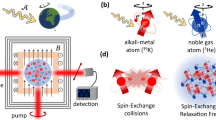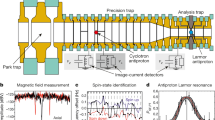Abstract
Ultralight axion-like particles are well-motivated dark matter candidates introduced by theories beyond the standard model of particle physics. However, directly constraining their parameter space with laboratory experiments usually yields weaker limits than indirect approaches relying on astrophysical observations. Here we report the search for axion-like particles with a quantum sensor in the mass range of 8.3–744.0 feV. The sensor makes use of hyperpolarized long-lived nuclear spins as a pre-amplifier that effectively enhances a coherently oscillating axion-like dark matter field by a factor of more than 100. Using these spin-based amplifiers, we achieve an ultrahigh magnetic sensitivity of 18 fT Hz–(1/2), which exceeds the performance of state-of-the-art nuclear spin magnetometers. Our experiment constrains the parameter space describing the coupling of axion-like particles to nucleons over the aforementioned mass range, namely, at 67.5 feV reaching 2.9 × 10−9 GeV−1, improving on previous laboratory constraints by at least five orders of magnitude. Our measurements also constrain the quadratic interaction between axion-like particles and nucleons as well as interactions between dark photons and nucleons, exceeding bounds from astrophysical observations.
This is a preview of subscription content, access via your institution
Access options
Access Nature and 54 other Nature Portfolio journals
Get Nature+, our best-value online-access subscription
$29.99 / 30 days
cancel any time
Subscribe to this journal
Receive 12 print issues and online access
$209.00 per year
only $17.42 per issue
Buy this article
- Purchase on Springer Link
- Instant access to full article PDF
Prices may be subject to local taxes which are calculated during checkout




Similar content being viewed by others
Data availability
Source data are provided with this paper. All other data that support the plots in this paper and other findings of this study are available from the corresponding author upon reasonable request.
Code availability
The code that supports the plots in this paper is available from the corresponding author upon reasonable request.
References
Bertone, G. & Hooper, D. History of dark matter. Rev. Mod. Phys. 90, 045002 (2018).
DeMille, D., Doyle, J. M. & Sushkov, A. O. Probing the frontiers of particle physics with tabletop-scale experiments. Science 357, 990–994 (2017).
Safronova, M. et al. Search for new physics with atoms and molecules. Rev. Mod. Phys. 90, 025008 (2018).
Bertone, G. & Tait, T. M. A new era in the search for dark matter. Nature 562, 51–56 (2018).
Ambrosi, G. et al. Direct detection of a break in the teraelectronvolt cosmic-ray spectrum of electrons and positrons. Nature 552, 63–66 (2017).
Aprile, E. et al. First dark matter search results from the XENON1T experiment. Phys. Rev. Lett. 119, 181301 (2017).
Liu, J., Chen, X. & Ji, X. Current status of direct dark matter detection experiments. Nat. Phys. 13, 212–216 (2017).
Peccei, R. D. & Quinn, H. R. CP conservation in the presence of pseudoparticles. Phys. Rev. Lett. 38, 1440–1443 (1977).
Preskill, J., Wise, M. B. & Wilczek, F. Cosmology of the invisible axion. Phys. Lett. B 120, 127–132 (1983).
Kim, J. E. & Carosi, G. Axions and the strong CP problem. Rev. Mod. Phys. 82, 557–601 (2010); erratum 91, 049902 (2019).
Irastorza, I. G. & Redondo, J. New experimental approaches in the search for axion-like particles. Prog. Part. Nucl. Phys. 102, 89–159 (2018).
Svrcek, P. & Witten, E. Axions in string theory. J. High Energ. Phys. 2006, 051 (2006).
Anastassopoulos, V. et al. New CAST limit on the axion–photon interaction. Nat. Phys. 13, 584–590 (2017).
Bradley, R. et al. Microwave cavity searches for dark-matter axions. Rev. Mod. Phys. 75, 777–817 (2003).
Zhong, L. et al. Results from phase 1 of the HAYSTAC microwave cavity axion experiment. Phys. Rev. D 97, 092001 (2018).
Braine, T. et al. Extended search for the invisible axion with the axion dark matter experiment. Phys. Rev. Lett. 124, 101303 (2020).
Ouellet, J. L. et al. First results from ABRACADABRA-10 cm: a search for sub-μeV axion dark matter. Phys. Rev. Lett. 122, 121802 (2019).
Gramolin, A. V., Aybas, D., Johnson, D., Adam, J. & Sushkov, A. O. Search for axion-like dark matter with ferromagnets. Nat. Phys. 17, 79–84 (2020).
Budker, D., Graham, P. W., Ledbetter, M., Rajendran, S. & Sushkov, A. O. Proposal for a cosmic axion spin precession experiment (CASPEr). Phys. Rev. X 4, 021030 (2014).
Roberts, B. et al. Limiting P-odd interactions of cosmic fields with electrons, protons, and neutrons. Phys. Rev. Lett. 113, 081601 (2014).
Graham, P. W. & Rajendran, S. Axion dark matter detection with cold molecules. Phys. Rev. D 84, 055013 (2011).
Stadnik, Y. & Flambaum, V. Axion-induced effects in atoms, molecules, and nuclei: parity nonconservation, anapole moments, electric dipole moments, and spin-gravity and spin-axion momentum couplings. Phys. Rev. D 89, 043522 (2014).
Kimball, D. F. J. et al. Overview of the cosmic axion spin precession experiment (CASPEr). In Microwave Cavities and Detectors for Axion Research 105–121 (Springer, 2020).
Jiang, M., Su, H., Wu, Z., Peng, X. & Budker, D. Floquet maser. Sci. Adv. 7, eabe0719 (2021).
Abel, C. et al. Search for axionlike dark matter through nuclear spin precession in electric and magnetic fields. Phys. Rev. X 7, 041034 (2017).
Wu, T. et al. Search for axionlike dark matter with a liquid-state nuclear spin comagnetometer. Phys. Rev. Lett. 122, 191302 (2019).
Smorra, C. et al. Direct limits on the interaction of antiprotons with axion-like dark matter. Nature 575, 310–314 (2019).
Garcon, A. et al. Constraints on bosonic dark matter from ultralow-field nuclear magnetic resonance. Sci. Adv. 5, eaax4539 (2019).
Graham, P. W. et al. Spin precession experiments for light axionic dark matter. Phys. Rev. D 97, 055006 (2018).
Graham, P. W. & Rajendran, S. New observables for direct detection of axion dark matter. Phys. Rev. D 88, 035023 (2013).
Aybas, D. et al. Search for axionlike dark matter using solid-state nuclear magnetic resonance. Phys. Rev. Lett. 126, 141802 (2021).
Bloch, I. M., Hochberg, Y., Kuflik, E. & Volansky, T. Axion-like relics: new constraints from old comagnetometer data. J. High Energ. Phys. 2020, 167 (2020).
Vysotsskii, M., Zel’Dovich, Y. B., Khlopov, M. Y. & Chechetkin, V. Some astrophysical limitations on the axion mass. JETP Lett. 27, 502–505 (1978).
Raffelt, G. G. Astrophysical axion bounds. In Axions 51–71 (Springer, 2008).
Arias, P. et al. WISPy cold dark matter. J. Cosmol. Astropart. Phys. 2012, 013 (2012).
Beznogov, M. V., Rrapaj, E., Page, D. & Reddy, S. Constraints on axion-like particles and nucleon pairing in dense matter from the hot neutron star in HESS J1731-347. Phys. Rev. C 98, 035802 (2018).
Carenza, P. et al. Improved axion emissivity from a supernova via nucleon-nucleon bremsstrahlung. J. Cosmol. Astropart. Phys. 2019, 016 (2019).
Kominis, I., Kornack, T., Allred, J. & Romalis, M. V. A subfemtotesla multichannel atomic magnetometer. Nature 422, 596–599 (2003).
Budker, D. & Romalis, M. Optical magnetometry. Nat. Phys. 3, 227–234 (2007).
Arvanitaki, A. & Geraci, A. A. Resonantly detecting axion-mediated forces with nuclear magnetic resonance. Phys. Rev. Lett. 113, 161801 (2014).
Walker, T. G. & Happer, W. Spin-exchange optical pumping of noble-gas nuclei. Rev. Mod. Phys. 69, 629–642 (1997).
Marsh, D. J. Axion cosmology. Phys. Rep. 643, 1–79 (2016).
Dine, M. & Fischler, W. The not-so-harmless axion. Phys. Lett. B 120, 137–141 (1983).
Kornack, T., Ghosh, R. & Romalis, M. Nuclear spin gyroscope based on an atomic comagnetometer. Phys. Rev. Lett. 95, 230801 (2005).
Centers, G. P. et al. Stochastic fluctuations of bosonic dark matter. Preprint at https://arxiv.org/abs/1905.13650 (2019).
Bar, N., Blum, K. & D’amico, G. Is there a supernova bound on axions? Phys. Rev. D 101, 123025 (2020).
DeRocco, W., Graham, P. W. & Rajendran, S. Exploring the robustness of stellar cooling constraints on light particles. Phys. Rev. D 102, 075015 (2020).
Pospelov, M. et al. Detecting domain walls of axionlike models using terrestrial experiments. Phys. Rev. Lett. 110, 021803 (2013).
Graham, P. W., Irastorza, I. G., Lamoreaux, S. K., Lindner, A. & van Bibber, K. A. Experimental searches for the axion and axion-like particles. Annu. Rev. Nucl. Part. Sci. 65, 485–514 (2015).
Aggarwal, N. et al. Characterization of magnetic field noise in the ARIADNE source mass rotor. Preprint at https://arxiv.org/abs/2011.12617 (2020).
Ji, W. et al. New experimental limits on exotic spin-spin-velocity-dependent interactions by using SmCo5 spin sources. Phys. Rev. Lett. 121, 261803 (2018).
Kim, Y. J., Chu, P.-H., Savukov, I. & Newman, S. Experimental limit on an exotic parity-odd spin- and velocity-dependent interaction using an optically polarized vapor. Nat. Commun. 10, 2245 (2019).
Cai, B. et al. Herriott-cavity-assisted all-optical atomic vector magnetometer. Phys. Rev. A 101, 053436 (2020).
Dailey, C. et al. Quantum sensor networks as exotic field telescopes for multi-messenger astronomy. Nat. Astron. 5, 150–158 (2020).
Acknowledgements
M.J., H.S. and X.P. were supported by the National Key Research and Development Program of China (grant no. 2018YFA0306600), National Natural Science Foundation of China (grants nos. 11661161018, 11927811 and 12004371), Anhui Initiative in Quantum Information Technologies (grant no. AHY050000) and USTC Research Funds of the Double First-Class Initiative (grant no. YD3540002002). D.B. and A.G. were supported by the Cluster of Excellence PRISMA+ funded by the German Research Foundation (DFG) within the German Excellence Strategy (project ID 39083149), by the European Research Council (ERC) under the European Union Horizon 2020 research and innovation programme (Dark-OsT project; grant agreement no. 695405), by the DFG Reinhart Koselleck project, and by the Emergent AI Center funded by Carl-Zeiss-Stiftung.
Author information
Authors and Affiliations
Contributions
M.J. designed the experimental protocols, analysed the data and wrote the manuscript. H.S. performed the experiments, analysed the data and wrote the manuscript. A.G. analysed the data and edited the manuscript. X.P. proposed the experimental concept, devised the experimental protocols and edited the manuscript. D.B. contributed to the design of the experiment, and proofread and edited the manuscript. All the authors contributed with discussions and checking the manuscript.
Corresponding author
Ethics declarations
Competing interests
The authors declare no competing interests.
Additional information
Peer review information Nature Physics thanks Claudio Gatti, Maurizio Giannotti and the other, anonymous, reviewer(s) for their contribution to the peer review of this work.
Publisher’s note Springer Nature remains neutral with regard to jurisdictional claims in published maps and institutional affiliations.
Supplementary information
Supplementary Information
Supplementary Figs. 1–15, text and references.
Source data
Source Data Fig. 2
Data for plotting Fig. 2d.
Source Data Fig. 3
Data for plotting Fig. 3a,b.
Source Data Fig. 4
Data for plotting Fig. 4b–d.
Rights and permissions
About this article
Cite this article
Jiang, M., Su, H., Garcon, A. et al. Search for axion-like dark matter with spin-based amplifiers. Nat. Phys. 17, 1402–1407 (2021). https://doi.org/10.1038/s41567-021-01392-z
Received:
Accepted:
Published:
Issue Date:
DOI: https://doi.org/10.1038/s41567-021-01392-z
This article is cited by
-
Long-baseline quantum sensor network as dark matter haloscope
Nature Communications (2024)
-
Constraints on axion-like dark matter from a SERF comagnetometer
Nature Communications (2023)
-
Fast In-Situ Triaxial Remanent Magnetic Field Measurement for Single-Beam SERF Atomic Magnetometer Based on Trisection Algorithm
Photonic Sensors (2023)
-
Review of noble-gas spin amplification via the spin-exchange collisions
Science China Information Sciences (2022)



